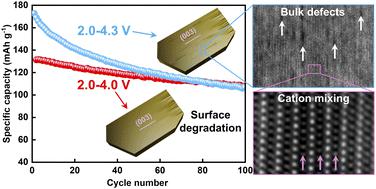当前位置:
X-MOL 学术
›
J. Mater. Chem. A
›
论文详情
Our official English website, www.x-mol.net, welcomes your feedback! (Note: you will need to create a separate account there.)
Deciphering cycling voltage-dependent failures of O3-layered cathode for sodium ion battery
Journal of Materials Chemistry A ( IF 11.9 ) Pub Date : 2024-04-08 , DOI: 10.1039/d3ta07967h Xuejiao Zhao 1 , Lihan Zhang 1 , Xiaoqi Wang 2 , Jinhui Li 1 , Lin Zhang 2 , Di Liu 2 , Rui Yang 2 , Xu Jin 2 , Manling Sui 1 , Pengfei Yan 1
Journal of Materials Chemistry A ( IF 11.9 ) Pub Date : 2024-04-08 , DOI: 10.1039/d3ta07967h Xuejiao Zhao 1 , Lihan Zhang 1 , Xiaoqi Wang 2 , Jinhui Li 1 , Lin Zhang 2 , Di Liu 2 , Rui Yang 2 , Xu Jin 2 , Manling Sui 1 , Pengfei Yan 1
Affiliation

|
The high energy density and low-cost O3-layered NaNi1/3Fe1/3Mn1/3O2 (NFM) is a representative layered cathode for sodium-ion batteries (SIBs). However, its long-term cycling stability needs further improvement and its high voltage usage is highly desired, which is quite challenging. The lack of full understanding of the cycling-induced failures hinders material optimization. Herein, we utilize advanced microanalysis techniques to comprehensively investigate the failure mechanisms of the O3-NFM layered cathode upon low-voltage (2.0–4.0 V) and high-voltage (2.0–4.3 V) cycling. We found that surface degradations play a dominant role during low-voltage cycling, and bulk failures become prominent upon high-voltage cycling. Surface cracking, corrosion, and structure transition together lead to slow charge transfer kinetics, resulting in chronic capacity decay. Bulk degradations such as intragranular cracking, void formation, and interlayer cation mixing severely deteriorate Na storage performance and Na diffusion kinetics, causing rapid capacity decay and voltage fading issues, which are the main challenges of the NFM layered cathode for high voltage usage. High charging cutoff voltage activates the cation migration and condensation, causing a highly disordered layered structure but no phase transition occurs in the bulk. Synergistically stabilizing the surface and bulk structure of the high-voltage O3-layered cathode is essential for achieving superior electrochemical performance.
中文翻译:

解读钠离子电池 O3 层状阴极的循环电压依赖性故障
高能量密度和低成本的O3层状NaNi 1/3 Fe 1/3 Mn 1/3 O 2 (NFM)是钠离子电池(SIB)的代表性层状正极。但其长期循环稳定性有待进一步提高,且高电压使用要求较高,具有一定的挑战性。对循环引起的失效缺乏充分了解阻碍了材料优化。在此,我们利用先进的微量分析技术来全面研究O3-NFM层状阴极在低电压(2.0-4.0 V)和高电压(2.0-4.3 V)循环时的失效机制。我们发现,表面退化在低电压循环过程中起主导作用,而整体失效在高电压循环过程中变得突出。表面裂纹、腐蚀和结构转变共同导致电荷转移动力学缓慢,导致容量慢性衰减。晶内裂纹、空隙形成和层间阳离子混合等整体降解严重恶化钠存储性能和钠扩散动力学,导致容量快速衰减和电压衰减问题,这是 NFM 层状正极在高电压使用时面临的主要挑战。高充电截止电压激活阳离子迁移和凝聚,导致高度无序的层状结构,但本体中不发生相变。协同稳定高压 O3 层状阴极的表面和体结构对于实现卓越的电化学性能至关重要。
更新日期:2024-04-08
中文翻译:

解读钠离子电池 O3 层状阴极的循环电压依赖性故障
高能量密度和低成本的O3层状NaNi 1/3 Fe 1/3 Mn 1/3 O 2 (NFM)是钠离子电池(SIB)的代表性层状正极。但其长期循环稳定性有待进一步提高,且高电压使用要求较高,具有一定的挑战性。对循环引起的失效缺乏充分了解阻碍了材料优化。在此,我们利用先进的微量分析技术来全面研究O3-NFM层状阴极在低电压(2.0-4.0 V)和高电压(2.0-4.3 V)循环时的失效机制。我们发现,表面退化在低电压循环过程中起主导作用,而整体失效在高电压循环过程中变得突出。表面裂纹、腐蚀和结构转变共同导致电荷转移动力学缓慢,导致容量慢性衰减。晶内裂纹、空隙形成和层间阳离子混合等整体降解严重恶化钠存储性能和钠扩散动力学,导致容量快速衰减和电压衰减问题,这是 NFM 层状正极在高电压使用时面临的主要挑战。高充电截止电压激活阳离子迁移和凝聚,导致高度无序的层状结构,但本体中不发生相变。协同稳定高压 O3 层状阴极的表面和体结构对于实现卓越的电化学性能至关重要。



























 京公网安备 11010802027423号
京公网安备 11010802027423号